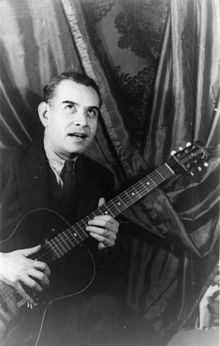Rufino Tamayo
Rufino Arellanes Tamayo (born August 26, 1899 in Oaxaca de Juárez , † June 24, 1991 ) was a Mexican painter of Zapotec origin.
After his mother's death, Tamayo moved to Mexico City to live with relatives in 1911. There he took lessons from 1915 in the evening classes of the Academia de San Carlos , in 1917 he became a student there with Leandro Izaguirre and Roberto Montenegro . From 1921 he was head of the department for ethnographic drawing at the Museo Nacional de Antropologia and from 1928 to 1930 he taught at the ENBA .
In his work he mainly dealt with the traditions of Mexico . He stood apart from the current prevailing at the time of giving painting a political message, as did, for example, José Clemente Orozco , Diego Rivera and David Alfaro Siqueiros . He developed a new kind of art called mixography , the most famous example of which is the work Dos Personajes Atacados por Perros .
His paintings and mixographies have been exhibited in well-known museums such as the Philips Collection Washington, DC and the Solomon R. Guggenheim Museum in New York. In 1959 Rufino Tamayo took part in the documenta II in Kassel .
Awards
- 1961: Admission to the American Academy of Arts and Letters
- 1974: Honorary doctorate from the University of Santo Tomas
- 1979: Honorary doctorate from UNAM
- 1979: Admission to the American Academy of Arts and Sciences
- 1980: Admission to the Academia de Artes
- 1982: Honorary Doctorate from the University of California
- 1988: Medalla Belisario Domínguez del Senado de la República
- 1991: Honorary doctorate from Universidad Veracruzana
Web links
- Rufino Tamayo Biography and paintings (English) (Persian)
- Museo Rufino Tamayo (Spanish)
- Literature by and about Rufino Tamayo in the catalog of the Ibero-American Institute of Prussian Cultural Heritage, Berlin
- Materials by and about Rufino Tamayo in the documenta archive
Individual evidence
- ↑ Honorary Members: Rufino Tamayo. American Academy of Arts and Letters, accessed March 24, 2019 .
| personal data | |
|---|---|
| SURNAME | Tamayo, Rufino |
| ALTERNATIVE NAMES | Tamayo, Rufino Arellanes |
| BRIEF DESCRIPTION | Mexican painter |
| DATE OF BIRTH | August 26, 1899 |
| PLACE OF BIRTH | Oaxaca de Juarez , Mexico |
| DATE OF DEATH | June 24, 1991 |
